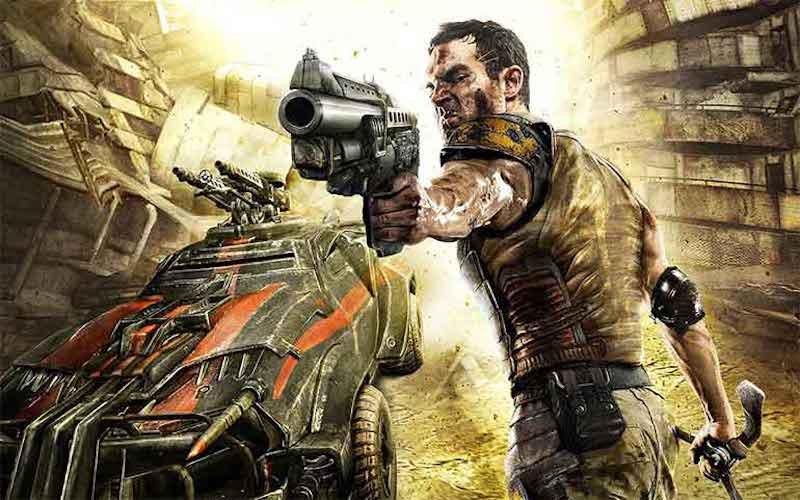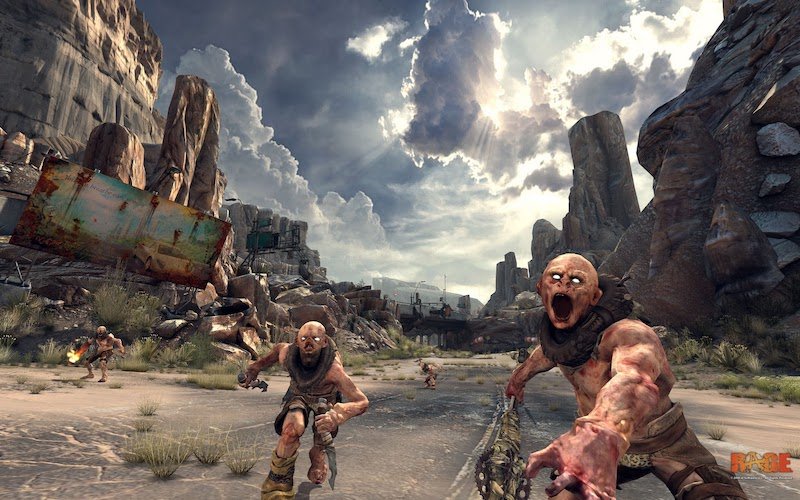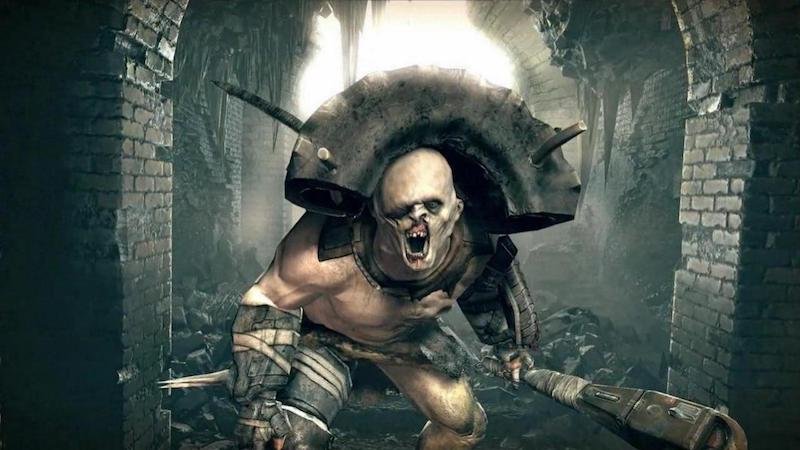RAGE Is About Killing Monsters

In the early ‘90s, id Software made a game called Wolfenstein 3D. That game cast players as BJ Blaskowitz, a Jewish killing machine stalking through Nazi territory toward a final showdown with Hitler. Because this is a video game, Hitler wears a robot suit and puts up a fight rather than offing himself in a bunker.
What Wolfenstein lacked in historical accuracy, it made up in visceral thrills. Players experienced the game’s world through BJ’s eyes and looked down the barrel of his gun; id had invented the first-person shooter. After Wolfenstein’s success, the team made DOOM, which was basically the same game as Wolfenstein, except players shot demons on Mars. Then they released DOOM II, which let you traipse around planet Earth shooting demons. Following DOOM id made Quake which was about shooting demons while time traveling. Their next games were Quake II and III which were about shooting demonic space-cyborgs. Then they made DOOM 3, which was about shooting Martian demons in the dark.
More recently, id released RAGE, a game about shooting people, mutants and cyborgs in a barren wasteland that was once the Earth we currently inhabit. RAGE is a game of enormous aspiration and minimal execution, the sort of thing that happens when people dream big before realizing they would actually rather make something small. There’s a fundamental immaturity to RAGE: this is the sort of game that kids dream up in the margins of their notebooks during a particularly boring geometry lecture. That doesn’t make it good, but I’d be lying if I said I disliked it.
Monosyllabic
The knock on id’s games is that they’re all the same, a series of endless corridors populated by various bad dudes that want nothing more than to kill the player’s character. There’s a trend in modern games to expand the emotional palette of both the player’s character and the forces that impede the player’s progress. Games from id Software are not about emotional palettes. They are about being a big dumb killing machine who feels single syllable emotions that look good when written in all caps.
Despite bearing the company’s standard naming conventions, RAGE feels like a conscious effort to broaden what people associate with an id game. This isn’t simply a game about shooting dudes in the face. It’s a game with a big open world that links together places where you can shoot dudes in the face. RAGE is heavily indebted to The Road Warrior, and when I say “heavily indebted,” I mean that the game’s post-apocalyptic wasteland looks exactly like the landscape George Miller dreamed up.
RAGE wants to be a game where players wander the wastes in search of treasure that will help them upgrade their gear. It wants to be a game where players spend time tuning beat-up hot rods to win races against computer-controlled opponents. More than anything RAGE wants to be a game about more than shooting dudes in the face. Despite these intentions, there’s an overwhelming feeling that the people who created the game lost interest in the driving and the car tuning and the infinite wonder of a burned-out wasteland about halfway through development. As a result, these bits are hopelessly undercooked. Instead of demonstrating the studio’s versatility, they emphasize that the company should have stuck to its guns.

Driving in Circles
The basic gameplay in RAGE follows a simple pattern that begins when you speak with a character in one of the game’s towns. There are two towns in RAGE where you pick up missions, and they’re both densely populated and functionally empty. You always know exactly who you need to speak with to advance the story, and speaking with anyone else feels like an unnecessary detour. Once you receive a mission, you run to a specific door within the city. Clicking on that door produces a text menu. You select “WASTELAND” from that menu. Then, you wait 15 seconds while the game loads the outdoors. When the loading screen disappears, you’re outside in your car. You follow directions marked on your map that take you directly to the place you need to go. Along the way, your car might be waylaid by hostile cars. While you could theoretically shoot these other cars, you don’t, because killing them doesn’t really offer a reward. Instead, you blast by them until your arrive at your destination. Inevitably, the entrance to your objective is obscured in a way that makes it impossible for your car to get close. At this point, you get out of your car and walk up to the marker on your map, which is a door. You click on that door and wait another 15 seconds while the game loads up a new level. Finally, the level finishes loading and you actually get to play the good parts of RAGE.
The good parts of RAGE involve marching through levels while looking down the barrel of a gun. They are prettier and more complex versions of the game that id has been making since Wolfenstein 3D. The entire sequence in between receiving a mission and actually ending up in the level that corresponds to that mission takes less than ten minutes on average, but ten minutes of busywork feels like a lifetime when you’re playing a game. Driving in the wasteland looks cool, but it contributes nothing to the game. By giving you an opportunity to explore the wasteland at all, the game’s creators actually make it seem less vast and imposing. Within half an hour of booting the game up, you realize it’s possible to drive from one end of the wasteland to the other in five minutes.
Run and Gun
The more you play RAGE, the clearer it becomes that the game was not crafted in adherence to some grand vision. Instead, this title was pieced together from the work of countless people on several different teams. The interstitial stuff in RAGE, the wandering around town to collect missions and the driving to mission zones, aims to stitch the game’s levels together with a compelling narrative, but instead it highlights the game’s patchwork nature. None of the levels in this game feel like they build on each other. The events that transpire in one area feel disconnected from the events in others, and the visual design of levels varies wildly. Because each level is separated by a load, you never get a sense of the world as a contiguous place. The only thing that binds these places together is the fact that you show up in them and kill every living thing.
More than corridors full of exploding barrels or the omnipresent gun jutting from the bottom of the screen, the dedication to killing everything is the real unifying factor between id’s games. There are no grey areas in the studio’s titles, they all paint the player as the lone force for good in a murderous world. These are games about monsters, and they’re couched in the assumption that every living thing has it out for you.
In RAGE, you never see the enemies interact with people in the towns. You are told that the enemies are bad, so you go to their hideouts and exterminate them. Marching through those hideouts feels fantastic; the game runs at a silky 60 frames per second and enemies respond in satisfyingly exaggerated ways when you hit them with bullets. Pulling the trigger in RAGE feels sharp and vital and necessary, but only when you’re deep in the bowels of a level. Once you’re back on the surface, wandering around a town full of bored-looking people, you’ll probably wonder what it was all for.

Hurt me plenty
The developers seem to have felt the same way. RAGE ends with a shrug; you reach the end of a level and it just happens to be the end of the game. Up until that point, the level was fun, in the way every RAGE level is fun. Angry things ran at you and you killed them before they killed you. There is no shame in making a game about killing monsters. The world is scary, and sometimes it’s satisfying to personify that fear with a bunch of polygons and blow it away with a digital shotgun. But tying those moments of monster-killing catharsis together with a story is a mistake. The story already exists when the first monster pops around a corner and beelines toward you. In that moment, you know exactly what you need to do to make it out alive. Tacking anything else on top of that experience simply adds dead weight. ★